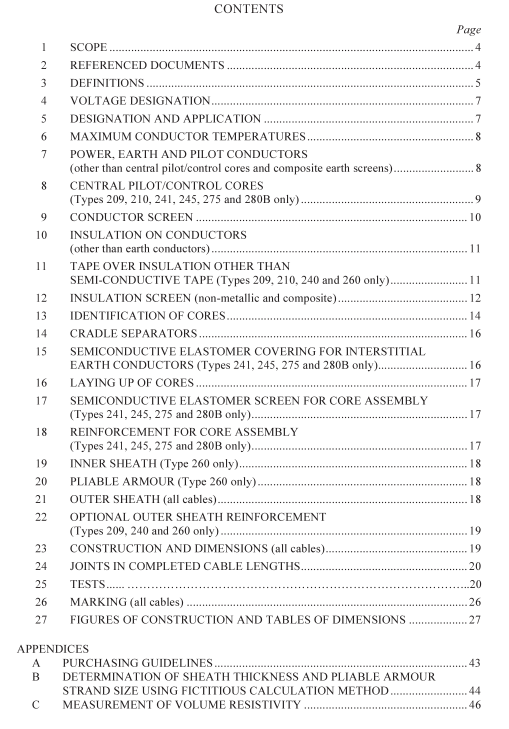AS NZS 1802 pdf download – Electric cables—Reeling and trailing— For underground coal mining

AS NZS 1802 pdf download – Electric cables—Reeling and trailing— For underground coal mining
3.12 Maximum conductor temperature The permitted maximum temperature at the surface of the conductor.
3.13 Multiple-stranded conductor A group of bunches or strands laid up helically and symmetrically such that within any one layer the length of lay of bunches or strands is uniform.
3.14 Pilot/control core An insulated conductor for use in conjunction with a protection or other control system.
3.15 Pitch circle diameter The diameter of a circle which passes through the midpoints of like cable components, e.g.—
(a) a given layer of bunches or strands in a multiple stranded conductor, or the laid-up cores of a multicore circular cable; or
(b) the composite screen of a core or strands of pliable armour in a circular cable. 3.16 Power core A power conductor with insulation of the appropriate voltage grade including, where applicable, semiconductive and composite screens.
3.17 Reeling and trailing cable A cable having flexible conductors, insulation incorporating conductor and insulation screens where appropriate, filling, reinforcement where appropriate, one or more protective coverings, and being specially designed to provide a flexible electrical connection between portable or mobile equipment and a point of supply.
3.18 Routine tests Tests made by the manufacturer on all completed cable to demonstrate the integrity of the cable.
3.19 Sample tests Tests made by the manufacturer on samples of completed cables or components taken from completed cables, at a specified frequency, so as to verify that the finished product meets the design specification.
3.20 Strand An assembly of wires laid up helically in one or more layers.
3.21 Type tests Tests required to be made before supplying on a general commercial basis a type of cable covered by this Standard, to demonstrate performance characteristics to satisfy the intended application. These tests are such that after they have been made, they need not be repeated unless changes are made in the cable materials or design which might change the performance characteristics.
4 VOLTAGE DESIGNATION Due to common usage in the mining industry, cables in this Standard have voltages designated using ‘phase voltage’/‘phase voltage’. However, although the cables specified for use with a.c. in this Standard are suitable in non-effectively earthed systems they are not intended for continuous operation with one phase earthed. The voltage designation takes into consideration the fact that the system voltage may vary up to 9.1 percent from the designated voltage.
5 DESIGNATION AND APPLICATION Cables are designated by means of a type number. The type number incorporates reference to the voltage, e.g. Type 209.3 identifies Type 209 rated at 3.3/3.3 kV. Types of cables and their applications are listed in Table 1. NOTE: For the cables specified in this Standard for use in underground coal mines, the first digit of the type number is 2. For those specified in AS/NZS 2802, for use in other than underground mining, the first digit of the type number is 4. These initial numerals have been chosen so that, for cables of like construction (e.g. as in the case of Types 209 and 409), the possibility of mistaken identity is reduced even after the cable has been worn or damaged.
6 MAXIMUM CONDUCTOR TEMPERATURES The maximum conductor temperature of cables is specified in Table 2. The emergency operation temperature (indicated in Column 2 of Table 2) is applicable for an average, over several years, of not more than one period per year. No period shall exceed 36 h and there shall not be more than three periods in any 12 consecutive months. The service life of cables may be reduced if flexed or reeled during emergency operation.
7 POWER, EARTH AND PILOT CONDUCTORS (other than central pilot/control cores and composite earth screens) 7.1 General Power, earth and pilot conductors shall consist of tinned annealed copper wires complying with the appropriate requirements of AS/NZS 1125, except that the wires taken from the completed cable need not comply with the continuity test for tin plating specified in AS/NZS 1660.1. Conductor sizes from 1.5 mm 2 up to and including 4 mm 2 shall be Class 5 flexible conductors and conductor sizes greater than 4 mm 2 and up to 400 mm 2 shall be multiple-stranded circular flexible conductors (rope lay).









